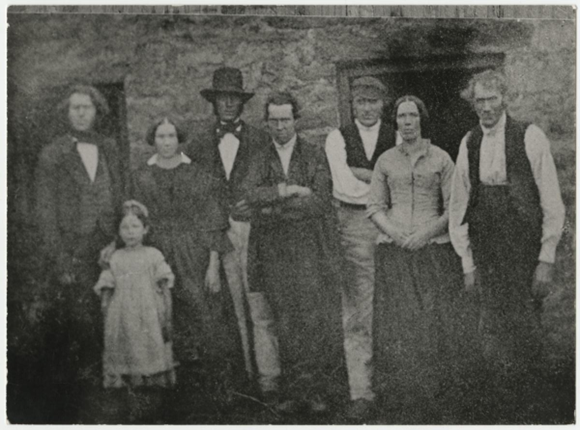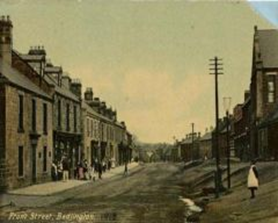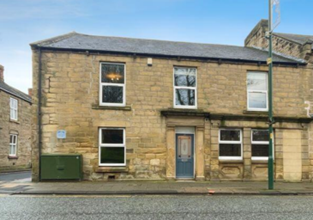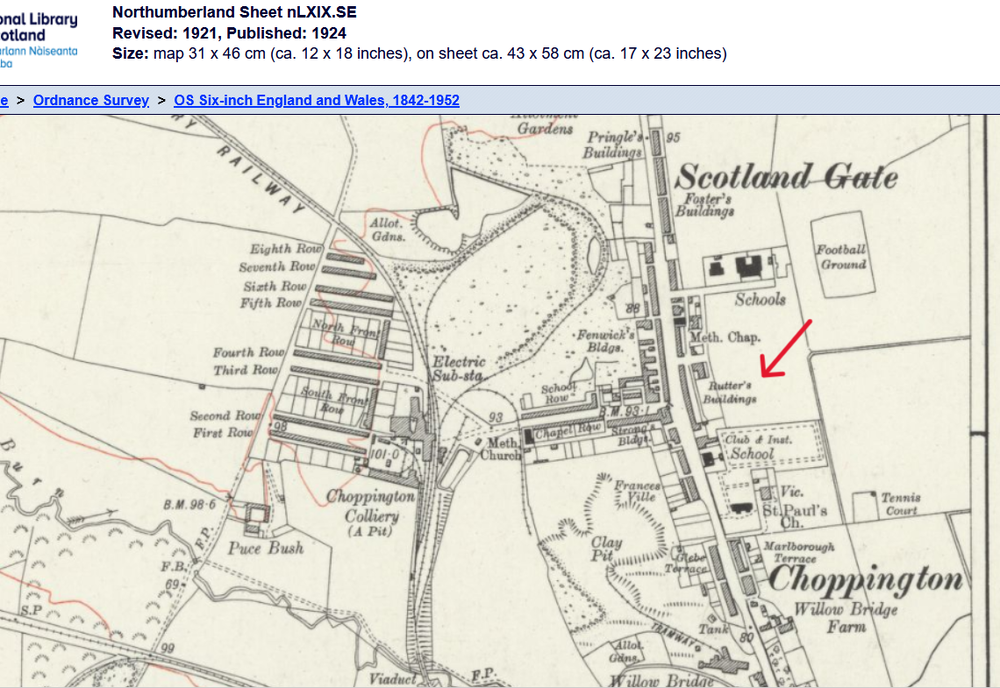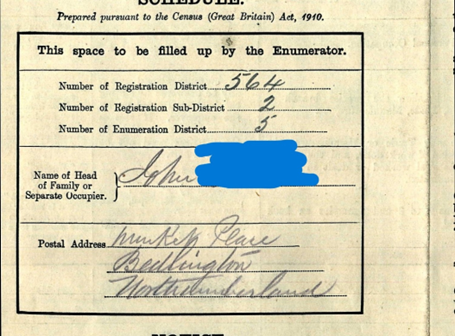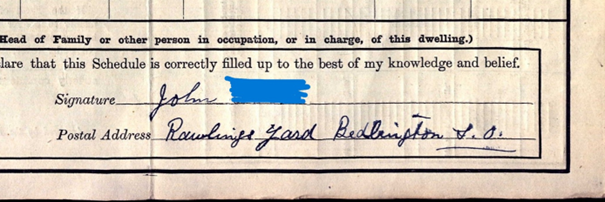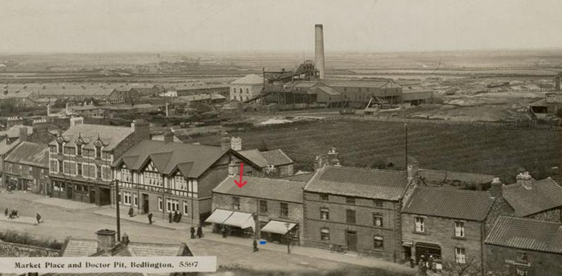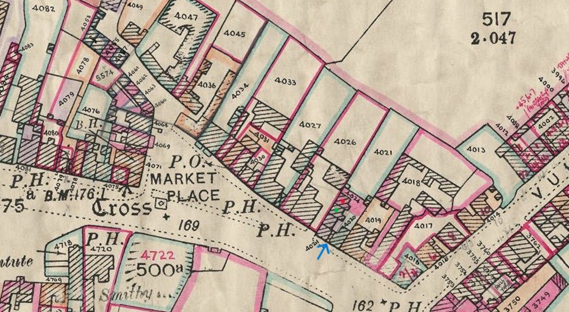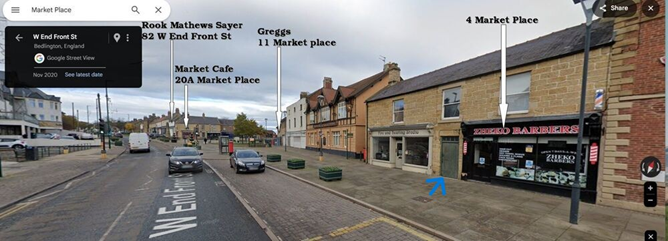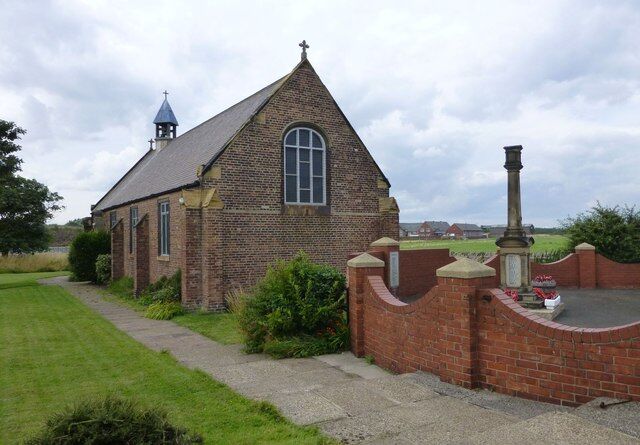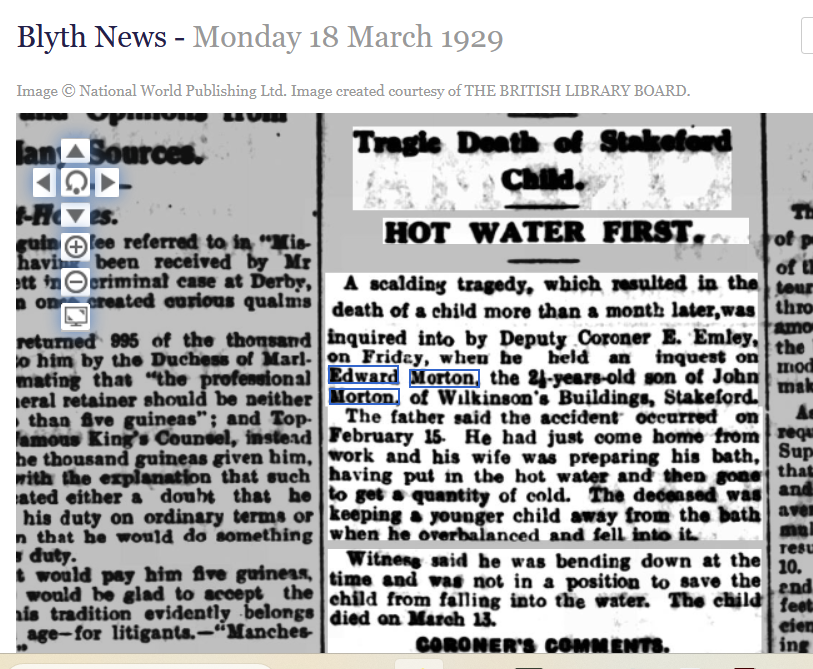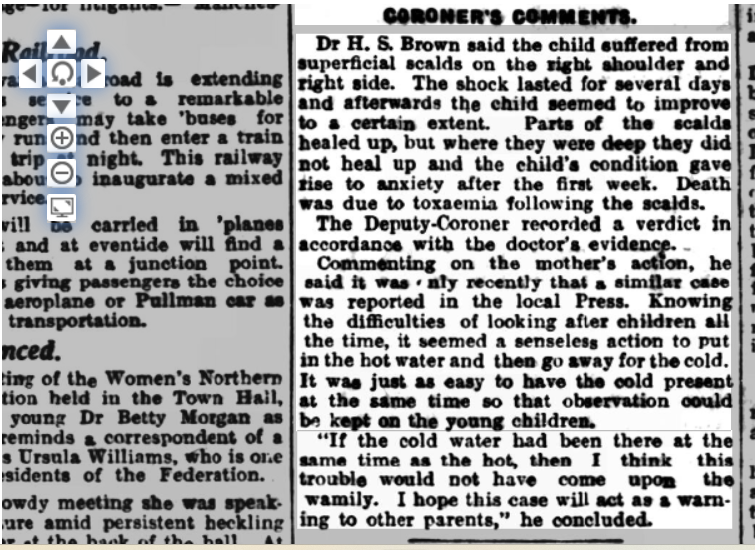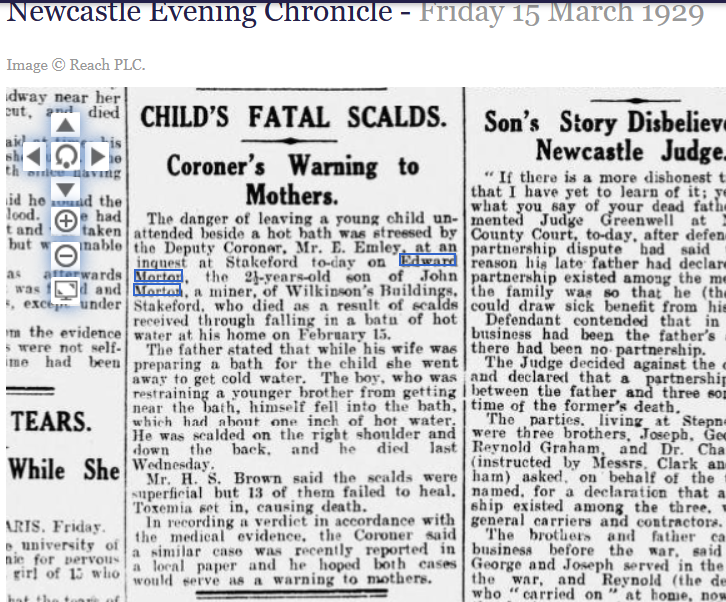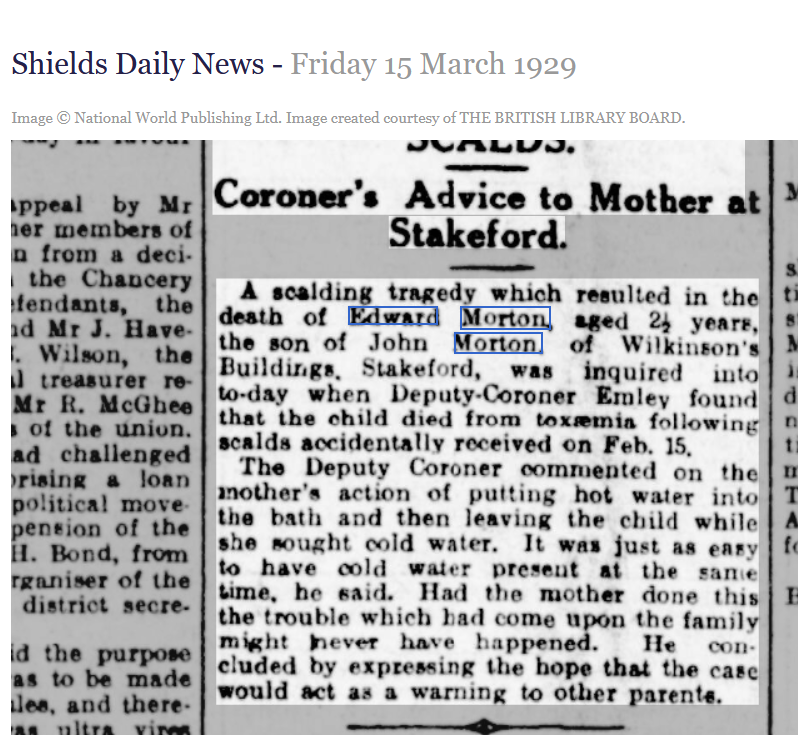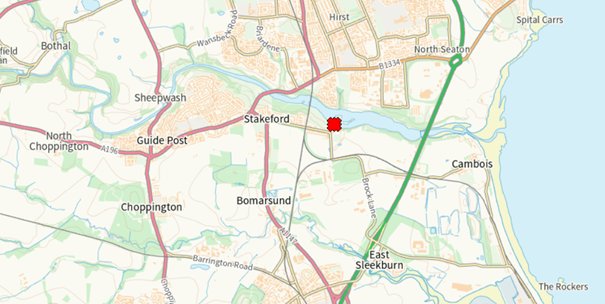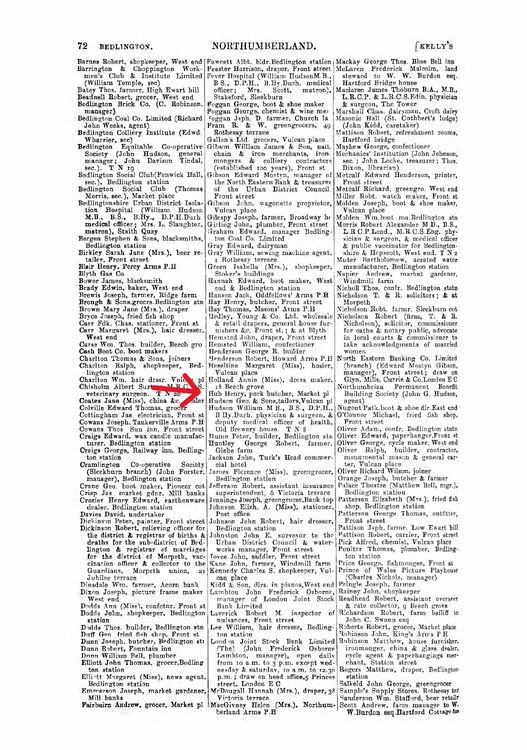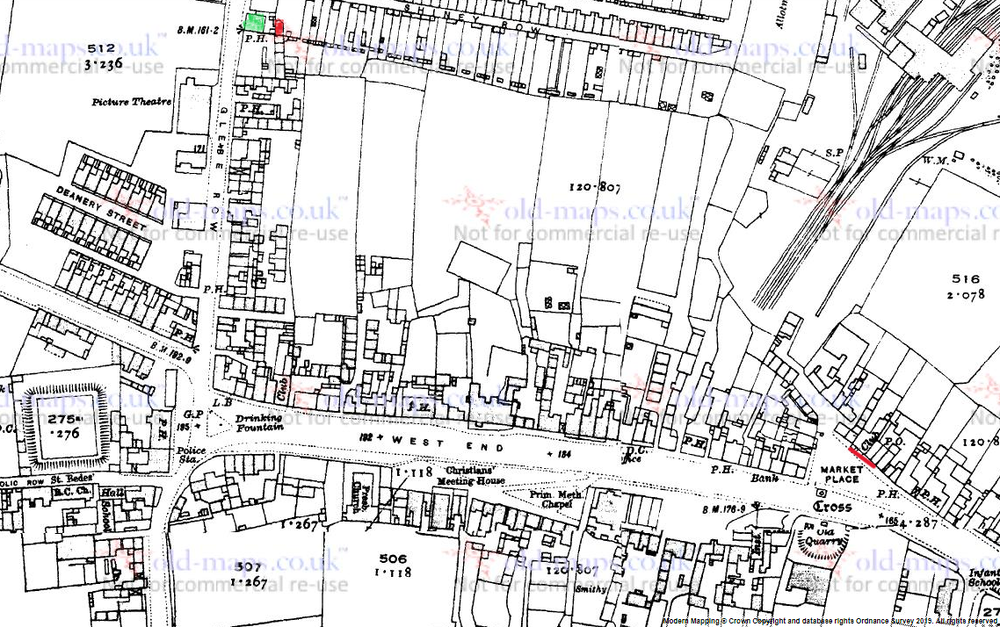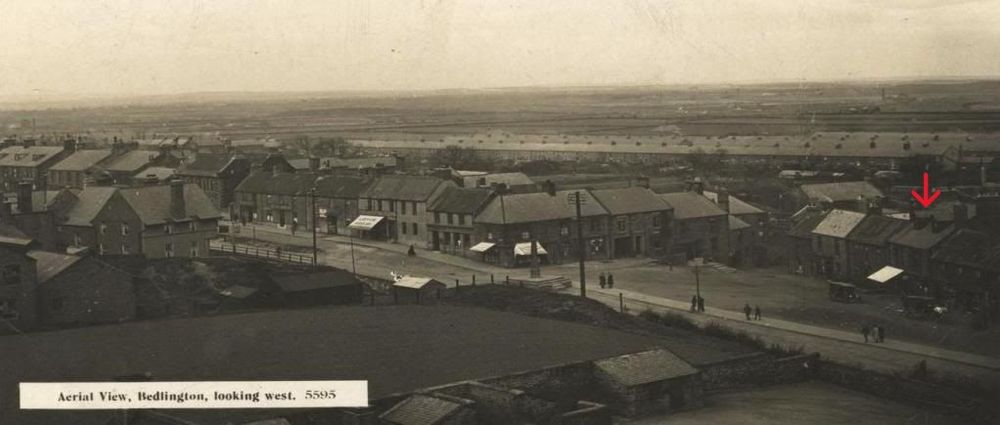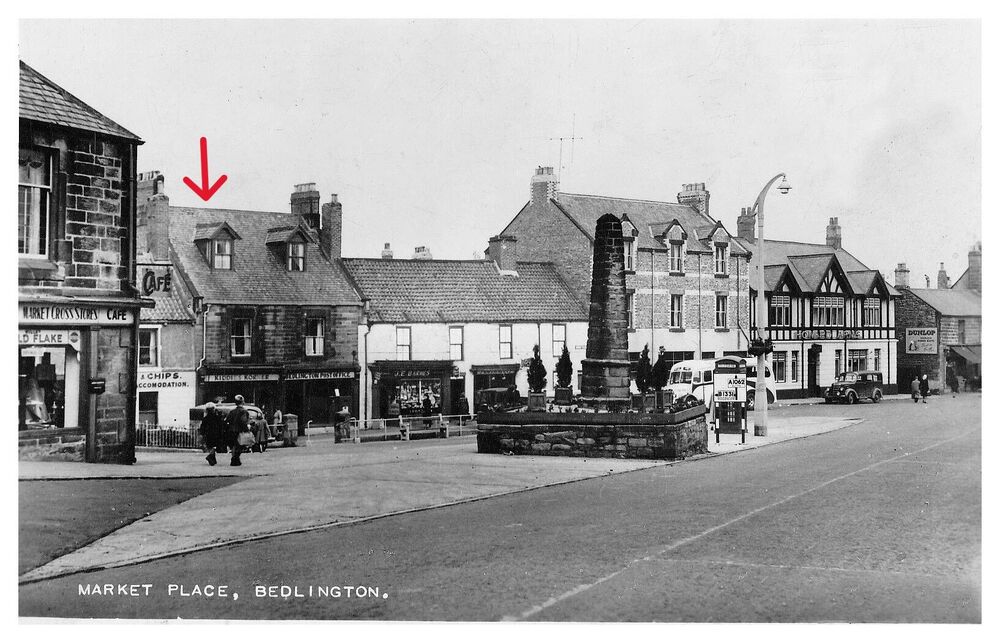.jpg.cdd7f8371d17e2f2f2e2a0e21e02f727.jpg)
Canny lass
Supporting Members-
Posts
3,596 -
Joined
-
Last visited
-
Days Won
407
Content Type
Forums
Gallery
Events
Shop
News
Audio Archive
Timeline
Everything posted by Canny lass
-
Thanks Eggy, I'd forgotten all about that. I must have had one of my 'senior moments'.
-
This will be long! Make a cuppa and get your feet up! The Gibson family research has had to wait while I've been without specs. The six weeks I was told would be needed before getting new specs after my ops turned into three months. I had the temporary specs only ta few days before I got a bleed inside my eye, another op and an inflammation that I wouldn't wish on my worst enemy! However, the Gibson family didn't have i easy either - read on! I left the widowed Henry Gibson in 1881, then aged about 67 years, living in the family home on Front Street east in Bedlington. He is still head of the family and the ironmongery business. Also resident are his two sons Philip Hedley Gibson, aged 34 and as yet unmarried, and William James Gibson, aged 26, who has with him his wife of eight months. She is Sarah (nee Mostyn), born to Edward Mostyn and his wife Anne in Flintshire, Wales, but the family moved to St Helens, Lancashire a few years after her birth and it is in St Helens the marriage took place. Sarah seems to have been a gifted child and was studying to become a teacher at the age of 17. Both brothers, having branched out into the world of banking, give their occupation as “Ironmonger & bank agent” but William James has the addition “nail & chain manufacturer”. The company is now calling itself “Gibson Bros & Co.” The “& Co” bit consists of – or at least includes - the husband of their sister, Jane Elizabeth, whom I mentioned earlier when she married engine wright John Archbold in 1863. Just when the partnership was formed is difficult to say but I can say with certainty that it ended in 1883 when, according to a notice in The Commercial Gazette 24 May 1883, the partnership was dissolved due to debts by William James Gibson and Philip Hedley Gibson to John Archbold. Thereafter, the Gibson family, father Henry and the two brothers, continue to run both businesses and despite being owed money, John Archbold doesn’t seem to have done too badly. On his death in 1897 he leaves to his family £2 871 – worth about a half million today (2025). The dissolution of the partnership is not the only misfortune to be suffered by the Gibsons around that time. William had married in 1880 and now it was the turn of older brother Philip Hedley. Like his brother, Philip Hedley does not marry a local girl but takes his bride, farmer’s daughter Jane Brookes, from Salop (Shropshire). They marry September 27, 1882 in the parish church of High Ercall, Salop. The marriage is, unfortunately, not to be a long one for Jane’s death is registered in the 2nd quarter of the following year. They were married for less than one year and as Jane’s death is registered in the Morpeth registration district it’s fair to assume that she had moved north to Bedlington with her husband. By 1891 we can see big changes in the family. Henry, the father, is now 77 years old and still working but the roles of father and son have now reversed. Philip Hedley, 44 year-old, is now the head of the household and his father, 77 year old Henry, is his assistant in the ironmongery business. Bank House must seem very empty now with only Philip Hedley, widowed, and his father living there together with a live-in general domestic servant. However, as I mentioned earlier, sister Mary Ellen and three of her children return to live at Bank House for a while before her death in 1901. William and his wife Sarah had, prior to 1891, moved to a home of their own, which brings me back to a photograph, posted by @johndawsonjune1955 which appeared in his first post in this topic: John Dawson could date the photo to 1888 and raised the question of where it might have been taken. @Maggie/915 thought it might have been taken at Vulcan Place, in Bedlington. I am now inclined to agree with her as it is in Vulcan Place, a few doors down from the Northumberland Arms, that William James and his family are living in 1891. At that time the couple have five children: Mary 8, Edward Mostyn 7, William Henry 5, Lilian 4 and James 9 months. If the photo is dated 1888 then the child in the photo could be the eldest child, Mary, who would then be about 5 years old, and the woman behind her could be her mother, Sarah. I’d then hazard a guess that one of the two men behind Sarah could be her husband, William James Gibson and the other may be his brother, Philip Hedley Gibson. Just a thought! The clothing of the three persons, 2 male and 1 female, to the right of the group suggests that they are workers and the tell-tale soot above the door behind them suggests to me that this could even be a nailer’s workshop. Could this have been to the rear of the buildings in Vulcan Place? The woman and child look as if they've just stepped out of the house for a minute, rather than being on a visit away from home. The man in the middle is, however, a mystery. Following the death of their 80 year-old father Henry in 1902, the brothers continue to run the business. Philip Hedley continues to live in Bank House on Front Street East and if the following photo is from 1910, as stated by Cympil (Gibson house is first on the left), then it must be Philip who is responsible for the neo-classic details, of which some still remain, on the building, and the new entrance (now blocked up) into the banking agent’s premises. Philip doesn’t marry again and has no children to take on the business after him when he dies shortly after his father, in 1906. Strangely, while Philip Hedley’s death occurs in Bedlington, his address is given as Newcastle on Tyne. He didn’t do too badly either, leaving £1 395 - worth about £216,761 today (2025). William James, on the other hand, has plenty of children and it’s to them I’ll look to see what happens the ironmongery and nailing business. A bit more research to do yet but it’s a fair bit easier now that I’ve finally got my specs! Watch this space!
- 18 replies
-
- 2
-

-
- furnace
- vulcan place
-
(and 2 more)
Tagged with:
-
Looking at that tea-pot, the terrier seems to have changed shape over the years. Did it not have it's lovely, cuddly, rounded back then! And .... what wouldn't I give to have a tea-pot like that at my 'afternoon teas' - surpassed only by Mrs Bucket's candlelight suppers!
-
.thumb.jpg.7493ddab4a696108cf2b849323d3c155.jpg)
Small building at the end of Furnace Bridge?
Canny lass replied to Joe Ridley's topic in History Hollow
Welcome to the forum @Thomas Carr Gray. May I ask what year you moved from Toll Cottage? -
Hi @Harry.T.S, welcome to the forum. As I said I’m not too familiar with the area but Rutters Buildings starts to appear on maps at some point between 1866 and 1896. It was a long row of housing lining the main road at Scotland Gate (between Choppington and Guide Post). In the 19 11 census there were 15 families living in Rutters Buildings. 13 of them were living in just 2 rooms and the remaining 2 families had 3 rooms each. There were some big families so living conditions for most were cramped, to say the least. Rutters buildings was located between the methodist church at the north end and the Kings Arms public house which adjoined the terrace at its southern end. You can see it on this map from 1924 which is the earliest on which I find its name but there may be others.
-
I don't know the area so well but I've never heard of Putters Buildings in Scotland Gate. Could it be Rutters Buildings - which did exist in the area? Handwriting ob certificates can be misleading. If you've recently obtained the certificate i has been transcribed from old documents which can be difficult to read.
-
.thumb.jpg.7493ddab4a696108cf2b849323d3c155.jpg)
Market Place houses early 20th century
Canny lass replied to Alan Edgar (Eggy1948)'s topic in History Hollow
@Margaret I Johnson Hi again! Am I right in thinking that John Tait was Mary Jane's third husband? -
.thumb.jpg.7493ddab4a696108cf2b849323d3c155.jpg)
Market Place houses early 20th century
Canny lass replied to Alan Edgar (Eggy1948)'s topic in History Hollow
@Margaret I JohnsonI have disappointing news! The John Tait recorded at Rawlings Yard (schedule 162 Market Place, Bedlington) in 1911 is married and his wife is with him. John was born at Holy Island and is 77 years old. His wife, Catherine, was born at Kelso and is now 73 years old. None of these details correspond to the information given on the census returns of 1891 for John Tait - husband of Mary Jane. However, the 3rd person in the household is John and Ann's grandson - John T Tait aged 21 years born about 1890 in Alnham, Northumberland. The John Tait being searched for by Margaret was born in Pasture Hill, Northumberland. That's about 20 miles as the crow flies from Alnham so they may well be related. I had a quick look in the 1911 census this morning and found a John Tait of the correct age (born 1855) with the same profession (mining) lodging in Hirst, Ashington. He, however, states that he is single which wouldn't be strange if he was separated. He gives his birthplace as Low Mill Northumberland which is less than 10 miles from Pasture Hill. Could it be the same person? -
.thumb.jpg.7493ddab4a696108cf2b849323d3c155.jpg)
Market Place houses early 20th century
Canny lass replied to Alan Edgar (Eggy1948)'s topic in History Hollow
@Alan Edgar (Eggy1948)Make yourself a cuppa! This is going to be long! It’s quite easy to mistake schedule numbers with house numbers. Another common mistake is to think that every schedule number is a house. What the census documents record are the number of ‘households’ and it is these ‘households’ that are given a schedule number. Space was at a premium and living space could be rented out by the room so that several households often lived in the same house. This was very common practice in Bedlington. At the time of the 1911 census, the ‘Market Place’ had 33 households of which one was a common lodging house with 25 male residents and one private house which was unoccupied. If we look at the enumerator’s summary book these 33 households, with the exception of the Post Office, the Turk’s Head public House and the Howard Arms Hotel all had the same address – Market Place Bedlington. This, you could say, was the ‘formal’ address at which the household resided. This was the address written by the enumerator on the census form which he delivered to the household to be filled in by the head of that household. It was also the address he used when transcribing the completed form to his summary book. While this system worked well for the enumerator, who had a set route to follow, it wasn’t the ideal system for the people who lived there should they, for example, need to impart the whereabouts of their home to intended visitors or tradesmen. The residents of the Market Place (and many other places) found their own way of describing their location and this was usually by means of easily identifiable features in the vicinity of their home. One of the wonderful things about the 1911 census is that the forms filled in by each household were not destroyed once the enumerator had transcribed their content to his summary book. The householders, regardless of what the enumerator had written on his part of the census form, often wrote their address in the manner in which they would give it to would-be visitors. So is the case with MarknMargaret’s relative, Mr John T, which greatly eases the task of identifying where he lived. The schedule nr 26 refers to this address written by the enumerator: Mr John T, however, gives the following address as his place of residence: In other words, John’s household comprising himself, his wife and his grandson, lived in the yard of the Rawlings family home. There were a number of such yards all along Front Street, Vulcan Place and Glebe Row. The main family home, in this case the Rawlings, faced the main street and the yard faced away from the street at the rear of the house. Basically, anything in the yard that was deemed ‘habitable’ could be rented out. They could be small houses to accommodate employees but equally well they could just be small outhouses or lean-to buildings. Mr William Rawling lived in the Market Place in a building facing the main street and in this building was also his business - Merchant Tailor & Mens Wear. The location is easily identifiable from its location, next door and to the east of the Howard Arms hotel, as recorded in the summary book. As I said, the enumerator had a set route to follow: Here is the Rawling family home and business, arrowed red. I’ve also marked a doorway, adjoining the tailor’s shop, in blue. This opened into a passageway leading to the yard: If you look closely at the angle between the house which I’ve arrowed and the larger building to its right, you can just make out the roof and chimney of the yard buildings where Mr John T lived. I don’t know the date of this photo but the map below is from 1910 and you can clearly see that there are two small buildings in the yard. These had each two rooms, one of which served as kitchen/livingroom/diningroom (and at times even as bedroom). In the first of these two buildings (marked green), adjoining the tailor’s shop, lived Mr William Errington, the previous occupier of the tailor’s shop. It was in his day, however, a grocer’s shop. He occupied just one room. In the second of the two houses (marked red) lived MarknMargaret’s relative, Mr John T, who occupied two rooms – probably one up and one down. On the map I’ve also arrowed in blue the doorway to the passageway which I marked in blue on the above photo This is the same doorway shown on Alan’s photo (reproduced below): Hope this is of help. If MarknMargaret would like copies of the original documentation let me know. If they could pass on an e-mail address through yourself, Alan, that would be ideal. -
.thumb.jpg.7493ddab4a696108cf2b849323d3c155.jpg)
Market Place houses early 20th century
Canny lass replied to Alan Edgar (Eggy1948)'s topic in History Hollow
We do our best! I'm now sure that T is correct and I've located the place. -
.thumb.jpg.7493ddab4a696108cf2b849323d3c155.jpg)
Market Place houses early 20th century
Canny lass replied to Alan Edgar (Eggy1948)'s topic in History Hollow
The Market Place 'dwellings' didn't have numbers in the 1911 census. Could Mark & Margaret be confusing the schedule number with a house number? Ask if her relative's surname started with the letter T? If so I can probably pin-point the right house for her. -
I would never have believed that of your good self! Did Bedlingtonians really get up to such mischief!
-
@Alan Edgar (Eggy1948) @AvrilG St Andrews wouldn't have a graveyard as it wasn't a parish church. All burials would take place at St Peters (West Sleekburn). As for the Methodist churches in Britain, the majority didn't have graveyards either. Their members were also 'parishioners' of the churches parish and were buried in the churchyard of the parish church. The Methodist church was allowed to do christenings and marriages and at some point the Methodist ministers were even granted permission to conduct marriage services within the parish church. Multi-denominational chapels in graveyards and crematoriums, together with municipal burial grounds solved the problem.
-
@AvrilG Living in Ashington makes things a lot easier for you! Pop along to the Northumberland Archives at Woodhorn. I'm pretty certain that they will have taken care of the parish records from St Peters (West Sleekburn). You can find their opening hours at https://www.northumberlandarchives.com/. I don't think you need to book before visiting. They can do a search for Edward’s grave, verify which cemetery and give you the plot number of his grave. I forgot to mention that St Peters (West Sleekurn) got a new cemetery when the original was full. It is located next door to the Forresters Arms on Wansbeck Terrace in West Sleekburn, and just opposite the site of the old St Peters church and cemetery. Just when it was opened, I can't be sure but it is registered by the Commonwealth War Graves Commission as having a few war graves from WW1 so it was there at the time of Edward's death. It might be worth having a wander round the gravestones to see if any names ring a bell.
-
So sorry about this mistake! It should of course say Edward's death and not Edwin. My sincere apologies.
-
I don't know if you know the area at all so I thought you might like these as well. The first, and larger, of the photos is St Andrew (Cambois) and the second, smaller, photo is St Peter (West Sleekburn. I'll get all of these off to your in-box now.
-
This report, from the Blyth News 18 March 1928 is quite long so it is in two separate files. Read them one after the other the coroner's comments are the second part.
-
The news of Edwin's death, or rather the coroner's inquiry into Edwins death, was quite widely reported in the North East. It must have been a trying time for the family. Here are some of the newspaper reports: More following.
-
@AvrilG We try to help when we can! Would you like me to post the cuttings here (they are digital copies) or would you like them sent to your private in-box?
-
Hi Hi @AvrilG! Welcome to the forum. If Edward was 2 years and 10 months, rather than ‘almost 2’ then I believe that the following is his obituary, published in the Newcastle Evening Chronicle on March 15 1929. My 11-year experience of rummaging through old documents, digital or hard copy, leads me to believe that the churchyard you refer to is Cambois Churchyard. Old newspapers, and therefore digitalised copies, can vary in quality due to the ravages of time. I can understand your mistaking Cambois for Cambels. The letter ‘i’ can look very much like the letter ‘l’ in faded or blurred print (compare the ‘li’ in ‘Bedlington’ next to the MORTON name). Likewise, ‘e’ and ‘o’. It might help you in your search to know that St Andrews (Cambois) was a small church built in the 1860s as the mission church of St Peter (West Sleekburn). West Sleekburn is often referred to as Bedlington Station, as in the obituary. St Andrews didn’t have the full status of a parish church but was supported by the parish. You could say that St Andrews was a ‘subsidiary’ of St Peters (West Sleekburn) which was the parish church of both West Sleekburn and Cambois. St Andrews was, therefore, served by the vicar of St Peters with the help of a non-stipendiary priest until its consecration in 1998 when it became a parish church. All parish records for St Andrews would be held at St Peters (West Sleekburn) until that date. Andy has given you a link to St Andrews and here you can see where St Peters is. Good luck with your search! I have some newspaper cuttings about Edwards death if you would like them.
-
.thumb.jpg.7493ddab4a696108cf2b849323d3c155.jpg)
Hub German Pork Butcher, Bedlington 1901-11
Canny lass replied to Richard Norton's topic in Friends and Family
PS Your great grandfather was still at the same address in Bedlington in 1914, before moving to Walker, Newcastle. His business appears in Kelly's Directory of that year. -
.thumb.jpg.7493ddab4a696108cf2b849323d3c155.jpg)
Hub German Pork Butcher, Bedlington 1901-11
Canny lass replied to Richard Norton's topic in Friends and Family
Hi @Richard Norton and welcome to the forum. Here is a map f and some photos that might interest you. The map is from 1922. In 1911 Henry was living and working in the building located between the Post Office and the Workingmen's Club. I've underlined these in red on the 1922 map so you can see the approximate area within the Market Place. In the following photo of the Market Place (1930) I've arrowed the house in which Henry lived and worked - the one with the white awning. I have no idea if he rented or owned the property but as he states that worked "at home" it's safe to say he lived on his work premises. The building is easy to locate from the 1901 and 1911 census records where it is always in the same location in relation to The Turks Head public house (the first PH to the right of my red line on the map). This next photo, date unknown) shows the market place from a different angle. I've arrowed the building again and you can clearly see the Post Office to its right, though Hub's Pork Butchers has now become Kiddies Corner. The Tudor style building to the far right is the Howard Arms. The larger building to its left is the Turks Head. The Fish & Chip shop to the left of Henry's house was previously the Workingmen's club - Henry's neighbour in 1911. I hope this is of some help. -
Englishmen and scotsmen may well have been the same thing back then. A scotsman once told me that a Geordie was ”a scotsman wi his brains bashed oot”. Cheeky b……!
-
.thumb.jpg.7493ddab4a696108cf2b849323d3c155.jpg)
The Garden of Remembrance at West Lea Cemetery.
Canny lass replied to Mal's topic in Talk of the Town
A proper little oasis!



